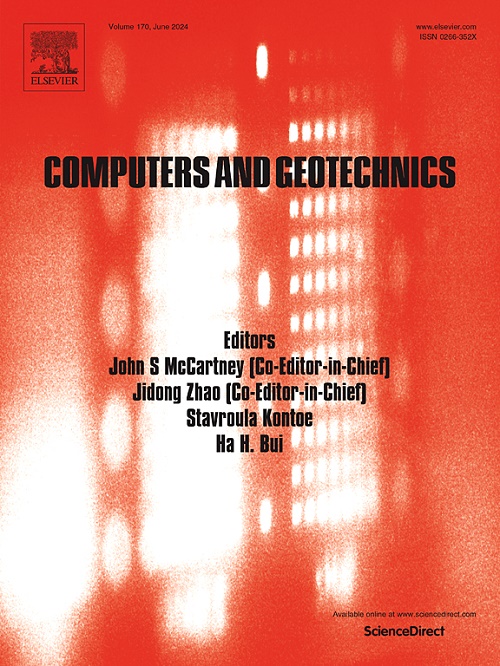Investigating the evolution of debris flow disaster in tunnels: model testing and numerical simulations
IF 5.3
1区 工程技术
Q1 COMPUTER SCIENCE, INTERDISCIPLINARY APPLICATIONS
引用次数: 0
Abstract
Water-mud inrush disasters in tunnels are prone to occur under high-pressure water-rich conditions in karst, granite alteration zone, jointed fracture dense zone. The debris flow strata have the characteristics of water-sensitive fractured geological structure, which easily lead to hydraulic connectivity, seepage failure and chain instability subjected to tunnelling disturbance. Accordingly, some tunnels have suffered from water-mud inrush disasters during construction in debris flow strata, even under general water level conditions. This research reproduces the evolutionary process of debris flow disaster from seepage failure to catastrophe, and reveals the characteristics of seeping, eroding and piping on the working face by model tests. Furthermore, PFC-CFD coupled numerical simulation in microscopic scale is applied to analyze the partial to overall instability behavior of the working face and the governing influencing factors. Considering the tunnelling disturbance, theoretical formulas for identification of minimum safe thickness of the rock mass in debris flow disaster are established. The results show that: (1) Prior to the occurrence of debris flow disasters, the seepage channel of the rock mass is gradually formed, and seepage holes appear on the working face. With seepage-erosion intensified, the seepage holes expanded, causing partial failure. Following a brief period of stability, the overall failure of the rock mass in front of the working face resulted in the occurrence of debris flow disasters. (2) As the debris flow disaster progresses, there are two mutations in the characteristic values, including those of water flow and kinetic energy. The evolutionary process is divided into three stages: pregnant, latent and occurrence. (3) Material composition and water pressure are the governing influencing factors for the start-up potential of debris flow disasters. When the equivalent friction angle of debris flow strata is reduced from 30° to 26°, the maximum kinetic energy is increased by about 26.7 %. The critical seepage pressure for debris flow disasters is about 0.5 MPa. (4) Subjected to the influence of tunnelling disturbance, the minimum safe thickness will exceed 5.3 m, with a maximum of up to 8.1 m. Qilian Mountain Tunnel has definitively established and implemented the minimum safe thickness of 9 m.
隧道泥石流灾害演化研究:模型试验与数值模拟
在岩溶、花岗岩蚀变带、节理裂隙密集带等高压富水条件下,隧道水泥突水灾害容易发生。泥石流地层具有水敏裂隙型地质构造的特点,易在掘进扰动作用下导致水力连通性、渗流破坏和链失稳。因此,即使在一般水位条件下,一些隧道在泥石流地层中施工时也会发生水泥涌灾害。本研究再现了泥石流灾害从渗流破坏到突变的演化过程,通过模型试验揭示了工作面渗流、侵蚀和管状的特征。在此基础上,采用微观尺度的PFC-CFD耦合数值模拟分析了工作面局部与整体失稳行为及控制影响因素。考虑隧道掘进扰动,建立了泥石流灾害中岩体最小安全厚度识别的理论公式。结果表明:(1)在泥石流灾害发生前,岩体渗流通道逐渐形成,工作面出现渗流孔;随着渗流侵蚀的加剧,渗流孔扩大,造成局部破坏。工作面前岩体经过短暂的稳定后,整体破坏导致泥石流灾害的发生。(2)泥石流灾害发生过程中,水流特征值和动能特征值发生了两次突变。进化过程分为三个阶段:孕育期、潜伏期和发生期。(3)材料成分和水压是泥石流灾害启动潜力的控制影响因素。当泥石流地层的等效摩擦角由30°减小到26°时,最大动能增加约26.7%。泥石流灾害的临界渗流压力约为0.5 MPa。(4)受掘进扰动影响,最小安全厚度将超过5.3 m,最大可达8.1 m。祁连山隧道确定并实施了9 m的最小安全厚度。
本文章由计算机程序翻译,如有差异,请以英文原文为准。
求助全文
约1分钟内获得全文
求助全文
来源期刊

Computers and Geotechnics
地学-地球科学综合
CiteScore
9.10
自引率
15.10%
发文量
438
审稿时长
45 days
期刊介绍:
The use of computers is firmly established in geotechnical engineering and continues to grow rapidly in both engineering practice and academe. The development of advanced numerical techniques and constitutive modeling, in conjunction with rapid developments in computer hardware, enables problems to be tackled that were unthinkable even a few years ago. Computers and Geotechnics provides an up-to-date reference for engineers and researchers engaged in computer aided analysis and research in geotechnical engineering. The journal is intended for an expeditious dissemination of advanced computer applications across a broad range of geotechnical topics. Contributions on advances in numerical algorithms, computer implementation of new constitutive models and probabilistic methods are especially encouraged.
 求助内容:
求助内容: 应助结果提醒方式:
应助结果提醒方式:


